-- MONDO magazine went offline several years ago. You are reading an archived version of this interview hosted on www.recordism.com --
Artists of the Week
William A. Davison and Sherri Lyn Higgins
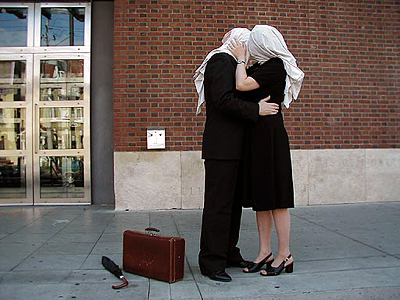
Songs of the New Erotics "The Lovers", Art Gallery of Ontario, 2002 (photo S.MacKay). Click for larger image.
By Kerry Wright Zentner
Posted June 18th, 2007
According to their website, "The Recordists are an amorphous collection of entities with no set membership" - a typically evasive bit of non-information from this Toronto-based art collective. Just who are these entities and what the heck is Recordism? Well, dear friends, that's what MONDO is about to find out! ...or not.
MONDO: Okay, so what is Recordism?
William A. Davison: Recordism can loosely be defined as an artistic ideology which is concerned with the continued development of certain forms of Fantastic Art, Literature, etc.; the investigation into and use of chance and automatic methods in current art practice; and an ongoing exploration of the connection between art and magick.
Recordism refers specifically to the act of 'recording' - a metaphor for the application of chance and automatism to the creative act. Recordism is both the process of ‘recording’ and the set of ideas which surround and inform that process.
Recordism is an ideospheric mutation of the meme known as Surrealism. It lives between the hairs of poet animals or in the dark folds of fabric on the masts of sunken ships.
Recordism is a loose, soft, downy mass of hair, feathers, etc.
Recordism is a length of string tied to the neck of a salamander.
Recordism is ice cream suits worn only on hot days.
Recordism is a flyspeck capable of occluding the sun.
Et cetera...
Uh, thanks...can I ask to whom I am speaking?
WD: William A. Davison and Sherri Lyn Higgins.
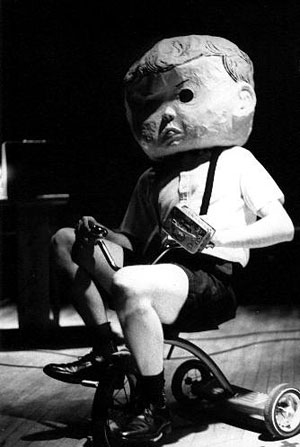
Songs of the New Erotics "The Anti-Child of Recordist Performance and a Lighted Cavern", 7a*11d Festival, Toronto, 1997 (photo S.Higgins).
That seems straightforward enough. Do the two of you represent the entirety of The Recordists or are there others?
WD: There are others, though not all will admit to it. Some may not even be aware of it.
At what point did you realize you were Recordists?
WD: It was the morning of Dec. 5, 1984. I woke up and wrote the word "Recordist" in my journal, not knowing where the word came from or what it might mean. It's taken me over 20 years to figure it out. I think I've almost got it.
Sherri Lyn Higgins: I'm still not sure that I am one.
The two of you have been making art together for a long time. Can you give us a quick overview of your various activities?
WD: No.
SH: William has trouble being brief.
WD+SH: The short version is that we met in small-town Nova Scotia and were part of a visual art collective there with some other misfits through much of the 80s. Then we went to art school (NSCAD) in Halifax, after which we moved to "the big smoke". In the early 90s, we proceeded to infiltrate various Toronto art scenes starting with underground film and experimental music, later performance art and the lit scene. We got involved in Neoism, collaborated with Istvan Kantor/Monty Cantsin, and played in Neoist industrial noise band Phycus. In 1994 we started the International Bureau of Recordist Investigation and began various networking and collective activities. We created the open concept improv/noise collective U.R.G. (Urban Refuse Group), built homemade instruments, and played tons of gigs. In 2000, U.R.G. got trimmed down to six members and became Six Heads. We hosted weekly open meetings to play Surrealist and Recordist games. We exhibited/published visual art/comics here and there. William did many solo sound/performance art pieces under the name Songs of the New Erotics. Sherri did a number of ritual-based performances under her own name. We curated events for 7a*11d Performance Art Festival and Pleasure Dome film group. We met Steve Venright and collaborated with Torpor Vigil Industries. Beatriz Hausner joined the Bureau, then unjoined the Bureau but remained a friend/collaborator. William had his poetry published. Sherri did CD covers and book jackets. We went away to New York and England to meet modern-day Surrealists and play improvised music with some of them. We disbanded I.B.R.I. in 2004 but continued with most of the same activities. We became friends with surrealists from and/or living in Mexico, Enrique Lechuga, Ludwig Zeller, Susana Wald. We got involved in Toronto's improvised music scene and then drifted towards noise, playing with Gastric Female Reflex and others. Through networking, we came into contact with San Francisco's Oneiromantic Ambiguity Collective and worked with irr.app.(ext.) and Steve Stapleton/Nurse With Wound. Recently, we've been drawing a lot with a certain KWZ.
And yes, that was the short version!
It's apparent that you both work in a variety of mediums - film, music, visual art, performance, poetry, etc. What draws you to this approach and how has it worked out for you?
SH: We are interested in freedom. Our approach is inter-disciplinary, or multi, or whatever. We don't like to feel limited or that we have to be specialized. There's always a pressure in the modern world to specialize. If you are an unknown artist working in a number of different mediums it's considered dilettantism or being "unfocussed". If you are well-known you are called a renaissance man (what are women called?) or a genius.
WD: What people often don’t understand is that we actually are specialized. We are Recordists. That’s our specialization. Our work is experimental, exploratory, and founded in a deep-seated belief that life, beyond the veneer of “civilization”, is essentially mysterious. It is, in fact, our specialization – our commitment to delving into this mysterious realm – that demands a multi-disciplinary approach and causes us to continually try new things, explore new mediums, and move across disciplinary boundaries.
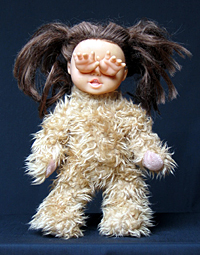
"Cutant" mixed media assemblage by W.A.Davison, 2007.
How do you deal with the stigma that is attached to working in more than one medium?
WD: It can be very frustrating, but no matter what you’re doing there will always be people who will try to limit you. We just shrug it off as much as possible and get on with our work. For the most part, I think it’s surprising how well we’ve been able to do this!
I think that having a really clear idea of what we’re doing really helps us to get consistently good results, regardless of what medium we happen to be working in, even if it’s a medium or technique that’s fairly new to us. We know what we want to do and we know what works and what doesn’t. Our ideas are in place. Hopefully, if people are able to get past their bias and actually look at/listen to what we’re doing, they’ll see that we’re serious about it and are producing something worthwhile.
Those who are interested in a high degree of craft however, may never appreciate our approach, rooted as it is in experimentation. But they’re not very “punk rock”, so we don’t care about them.
You say you know what you want to do within a particular medium. Does that mean you work from pre-conceived ideas?
WD: No. When I say we know what we want to do I'm talking about our artistic work in general - our overall direction or goals.
As far as creating each individual piece goes, we almost never work from pre-conceived ideas. Each work is derived through various chance, intuitive, or automatic processes - games, improvisation, random sparks of inspiration, dreams and so on. The final result of each work should come as a surprise.
At the same time, it's not entirely random. Our ideas and our artistic sensibilities are guiding things along in subtle ways (or not so subtle ways).
You each have your own artistic work but have also collaborated with each other many times, as well as with other artists. How is collaboration significant to you?
SH: It increases the chance element, which is always important to us. Also, there is this idea that the sum can be greater than the parts. Once Genesis P Orridge came to town and he was talking about his collaborations with Brian Gysin. He mentioned that collaboration (between for example, two people) could produce a third consciousness. Gysin wrote a book about this idea called The Third Mind, which I have yet to read. This concept really interests me.
WD: Again, there is the influence of Surrealism. The Surrealists were definitely very interested in group experiments and collaborative work, mostly because of the chance thing as Sherri mentioned, and we have the same impulses. It's just another method of circumventing rational thinking.
It's also a lot of fun working with other people and not knowing what’s going to happen!
Of course, we’re mostly talking about certain kinds of collaboration here – ones that involve game-like strategies, improvisation, etc. There are lots of other ways to collaborate, some of which interest us more than others.
In addition to collaboration, improvisation seems to be a major mode of working for you. Is this just a music thing or does it extend into other media? What do you like about improvising and how does it compare to other, more "pre-conceived" ways of working?
WD: Well, improvisation is essentially working to produce something with what's immediately at hand, usually working very quickly and in circumstances involving a lot of unknown variables. The end result may be pre-conceived or left entirely open, but the process itself -- the way to get to the end -- is a complete mystery and unfolds entirely in the moment. The artist or artists bring their knowledge and skills to the task, but obviously there is a lot of randomness, intuitive or non-rational thinking, etc. shaping the work as it develops. Chance, intuition... not hard to see why we would be interested in improvisation.
Some mediums seem to lend themselves easily to improvisational approaches. Music is the obvious one but it's entirely possible in other art forms as well. For instance, lately we've been doing a lot of collective drawing where we build up individual drawings by taking turns adding bits and pieces to them. It's amazing to see many of the exact same processes at work in collective drawing as I see in improvised music!
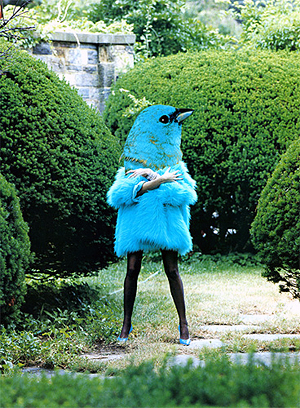
"Bird Lady (Blue)" photomontage by S.Higgins, 2006.
What are your influences, both individual and collective? What makes you guys so weird?
SH: The village in Nova Scotia where I did much of my growing up has a claim to fame in the person of Anna Swan, long-dead Victorian giantess who was born nearby and exhibited worldwide by P.T. Barnum. As a kid I used to visit the local museum to see her boot and a few other artifacts along with a stuffed two-headed calf that was the other prized item in their collection. My father's family and others (mostly older people) believed in ghosts, premonitions etc., so I grew up influenced by Nova Scotian folklore. My mother's family, originally from Yorkshire, were lovers of nonsense and nursery rhymes.
WD: Sherri and I share quite a number of early influences. We both have Nova Scotian fathers and did our growing up there. I was influenced by the folk culture there the same way Sherri was. We both have English mothers (mine from London) and so I’ve absorbed some of that UK thing as well.
SH: As children, William and I were both affected by strange TV culture in the 60s and early 70s. Shows like Art Clokey's “Gumby” and Sid and Marty Krofft's psychedelic kids’ show “H.R. Pufnstuf” had a profound impact. We also both watched “Monty Python's Flying Circus” when we were young.
WD: I would add to the list “The Prisoner” and maybe the 1960’s “Spiderman” cartoons (especially the music!). I was more influenced by comics and cartoons than Sherri was and I had a strong interest in science fiction from an early age. I also came from a musical family, so that was obviously an influence.
There were a number of pivotal influences for me that came along in my teens and early twenties, a couple of which I’d like to mention. There was a book called The World of Marcel Duchamp that got me into fine art and introduced me to Dada and Surrealism. There was Heavy Metal magazine, which, aside from introducing me to a lot of interesting European comic artists, also got me into experimental music via Lou Stathis’ “Muzick” column (this was in the late 70s/early 80s - can’t say much about the magazine now). There was hearing Nurse With Wound for the first time. And so on…
SH: As a teen I got into the occult. I spent time in the woods exploring my imagination. I was reading a lot at the time. I read my first Tom Robbins book, Still Life with Wood Pecker. He was a big influence on me, although I may not have realized it at the time. After I moved away, I got to hear experimental/underground music from friends with record collections, saw films like David Lynch's Eraserhead, and discovered Surrealism. Max Ernst and Leonora Carrington were important to me.
WD: Like Sherri, I discovered the occult and strange phenomena at an early age and it remains a major influence. Obviously, we both share a love of Dada and Surrealism. I’ve been most influenced by Max Ernst, Duchamp, Tristan Tzara, and probably a few others I can’t think of right now.
Sherri didn’t mention this, but punk has been a major influence on both of us – me through direct involvement and Sherri more indirectly through me. I think the idea of always questioning conventional attitudes and behavior was instilled in me well before the punk movement but punk certainly crystallized it for me and made it more a way of life. The DIY/make-your-own-culture attitude of punk also remains important to me.
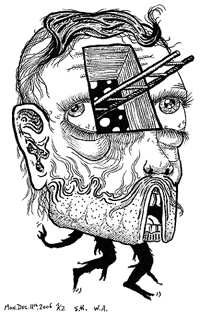
Collaborative drawing by W.A.Davison, S.Higgins, K.Zentner, 2006.
Do you have a specific agenda with your work?
WD: World domination, naturally.
SH: Splunge!
Why do you like hats?
WD: They're cute and furry and I like the way they hang upside down and suck your blood. Did you say bats?
SH: Our friend April had a pet bat that slept in an old mitten.
Do you have any current projects, forthcoming releases, etc. that you would like to talk about?
WD: Our record label Disembraining Songs is, I think, going to make the switch to being a netlabel, so that's exciting. It will mean re-releasing much of our past catalogue and most subsequent releases as free downloads which should open up our “market” considerably and get a lot more people hearing what we do. I used to love the physical thing of making the cassette and CD packages myself, but I have a lot less time for that kind of thing these days and, to be perfectly honest, I generally suck at getting the product out to people. It was never about making money anyway, so it's exciting to think that I can get a lot more product out and into the hands of way more people if all I have to do is upload some mp3s and jpgs and tell folks where they can download them!
As noted earlier, we’ve been doing a lot of collective drawing recently. It’s actually a project that’s been going for a few years now so we’ve built up a fair body of work. It’s getting to the point where we’re going to formalize the project with a name and start exhibiting/publishing it. So keep an eye out for that.
Always lots of music projects on the go, releases coming out on various small labels, lots of live performances, etc.
I have some illustrations appearing in the Jul/Aug issue of The Walrus.
Lots of other stuff too. We’re always very busy!
People can check up on our activities at The Organ Grinder’s Gazette.
How can people find out more about you and your work?
www.recordism.com if you can believe anything they say!
